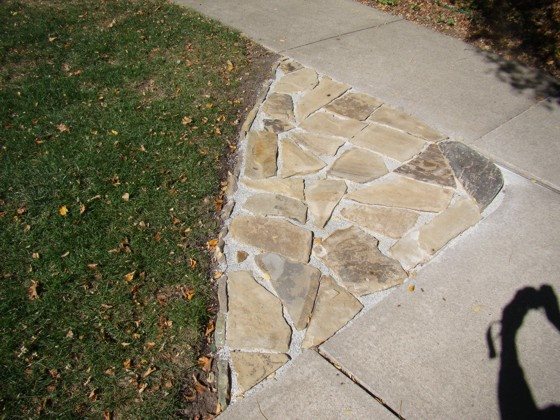Stone Walkway Installation Tips

The small loose stones between the pieces of rock can cause a mess. Photo Credit: Ron Bergnal, Chicago, IL
Stone Walkway
DEAR TIM: I want to install some flat pieces of rock for a walkway. I'm also using this same stone to make a shortcut where two sidewalks meet at a 90-degree angle. Do you have suggestions on how to trim the stone to fit, how to set the stone in place and what to fill in the joints with between each piece of stone? I've seen TV shows where they just pour small pieces of rock between the large pieces of stone. - Ron Bergnal, Chicago, IL
DEAR RON: I'm quite sure I can help you with this project as I've got lots of experience creating walkways using brick, stone and other masonry materials. Perhaps you can learn best from my failures and successes.
When I was a greenhorn in the construction business, I decided to install a gorgeous brick sidewalk at the second home my wife and I rehabilitated. Back in the 1970's, home improvement television shows were in their infancy and I watched a show where a man said to just lay the brick in coarse sand. All you had to do was level the sand, butt the brick against one another and sweep fine sand between the cracks in the brick.
That seemed like a great idea, and it was most certainly easier and less expensive than putting the brick down in concrete or on a gravel base. I proceeded with the job and it really came out looking spectacular.
But then I discovered that the bricks would shift at the edges, sand would track constantly into the house and weeds growing between the brick were a constant nuisance. In other words, my new brick walkway was a disaster.
A few years before, I had installed a brick walkway and path for my future mother-in-law where you blended coarse damp sand with Portland cement, spread this mixture about 3 inched thick, level it and then tamp it. You then butt the brick on top of this and sweep the cracks with fine sand mixed with Portland cement.
This patio, to this day, still looks fantastic. It was a grand success, and only a few of the edge brick ever popped loose. The few weeds that grew in the cracks were easily removed or treated with weed killer.
My best stone and brick walkways involved more work, but thirty years later they look the same as the day I installed them.
I discovered if you want really professional results you install the stone or brick on top of poured concrete that contains reinforcing steel. The reinforced concrete creates a solid foundation for the finished stone or brick so that it resists frost heave or other ground movement.
I would mortar the brick or the stone to the concrete slab with regular mortar made from medium sand and Portland cement. The mortar bed was usually only one-half-inch thick. I would mix three parts sand to one part Portland cement for this bedding mortar.
The spaces between each piece of stone or brick was filled with extremely strong mortar made from clean sand and lots of Portland cement. I wanted a mortar that would possibly last 50 to 100 years so that I wouldn't ever have to worry about tuckpointing it.
I would estimate that the compressive strength of the mortar exceeds 8,000 pounds per square inch because it contains so much Portland cement. I made this mortar by mixing one part sand to one part Portland cement. It was extremely rich in cement content, but fortunately a bag of Portland cement is not really expensive.
I discovered that you could use a tired old circular saw equipped with an abrasive masonry blade to create crisp cut lines in both brick and stone. If you desire the more rustic hand-chipped look on the edges of the stone, you can use the saw to make a score line on the bottom of the stone just under where you want the jagged line to appear.
Cut the stone at least halfway through its thickness and then tap the top side of the stone with a hammer along the line you want to create. This should produce an acceptable jagged line when the stone splits off.
Installing stone, brick or any other finished masonry material on top of a poured concrete base is lots of work. When I watch the modern television shows that show the fast and easy method, I usually chuckle because the young people on camera remind me of myself when I thought it was a grand idea to take the shortcut placing the brick in the sand.
If you do decide to place your stone on top of a concrete base, don't spend the time to put a smooth finish on it. You want the concrete to be in the same plane with no humps in it, but a simple screeded finish with some holes in it will do just fine. The coarse finish helps hold the bedding mortar to the concrete.
Column 988